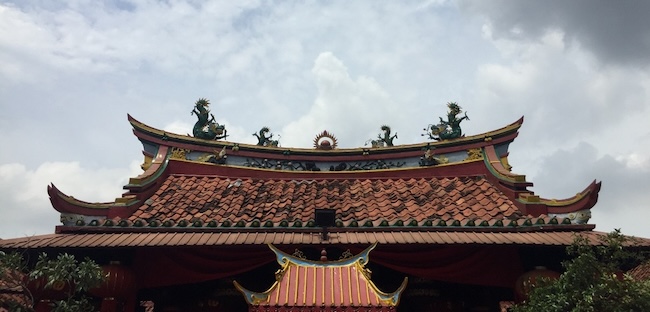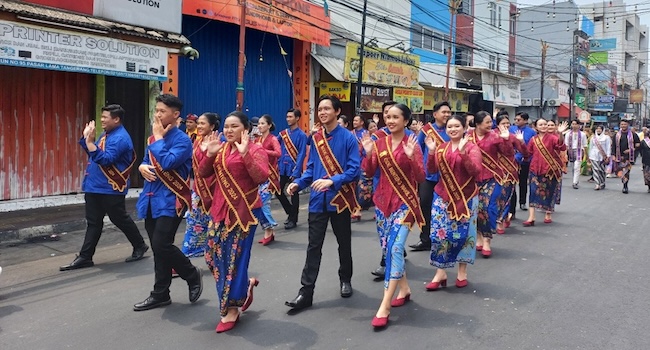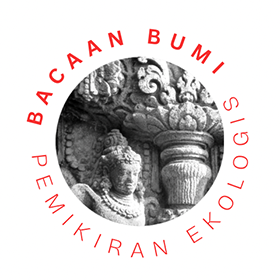Through decades of shifting political landscapes, Tangerang's Chinese community has preserved their sacred traditions
Ferhandi Prasetyo
On 21 September 2024, the streets around Pasar Lama, Tangerang came alive as thousands of people gathered for the much-anticipated Gotong Toapekong, a once-in-twelve-years procession organised by the Tangerang Chinese community. The roots of this tradition date back to the Year of the Dragon in 1844, when Boen Tek Bio, a historic Chinese temple in Tangerang, underwent a major renovation.
Originally built in 1684 by Chinese traders in Petak Sembilan – now Kali Pasir village – the temple stands at the heart of present-day Tangerang City. Boen Tek Bio, which translates to ‘Temple of Literature and Virtue’, has two sibling temples: Boen San Bio in nearby Pasar Baru, built in 1689, and Boen Hay Bio in South Tangerang, established in 1694. All three temples stand along the banks of the Cisadane River, forming a straight line when viewed from above. The underlying philosophy of these temples is: ‘Virtue (Tek) is as High as a Mountain (San) and as Wide as the Ocean (Hay).’
In 1844, with the help of Chinese craftsmen Boen Tek Bio was revitalised, incorporating authentic Chinese architectural elements. During the renovation, statues of deities were temporarily moved to the Boen San Bio temple. After months of work, the local community carried the statues back in a grand procession. These statues included Hok Tek Ceng Sien (God of Earth), Ka Lam Ya (Temple Guardian), Kwan Seng Tee Kun (God of War) and Kwan Im (Goddess of Mercy).

To commemorate the return of these sacred statues, the first Gotong Toapekong procession was held in the eighth month of the following Year of the Dragon, 1856. Since then, this sacred ritual has been a cherished tradition for the Tangerang Chinese community, held every 12 years with one exception.
In 1988, what would have been the 12th procession was not held. Some attribute this absence to Presidential Instruction No. 14/1967, enacted by Suharto during the New Order, which restricted Chinese cultural and religious practices in public spaces. Others believe it was also linked to the death of Sri Sultan Hamengkubuwono IX on 2 October 1988, a highly respected national figure whose passing led to a period of national mourning in Indonesia.
As recorded in history, during the colonial era and after independence, various special regulations were applied to the Chinese community, not only in Tangerang but across Indonesia. The tension intensified in 1965 when locals suspected the Chinese community of being involved in the G30S (Gerakan 30 September; 30th September Movement) tragedy. Under the New Order, Chinese Indonesians faced further discrimination, which restricted the development of their social and cultural activities. Despite this, the Tangerang Chinese community continued to practise traditions such as Cap Go Meh, Peh Cun and Ceng Beng, albeit in a more subtle manner. This could explain why the eleventh Gotong Toapekong procession was still able to take place in 1976.

In early January 2000, two years after the reformasi era commenced, President Abdurrahman Wahid (Gus Dur) repealed the presidential instruction banning Chinese cultural and religious performances in public spaces, allowing Gotong Toapekong to return with greater vibrancy. According to locals who took part, the thirteenth procession was monumental, as it saw participation from non-Chinese communities as well. Since then, Gotong Toapekong has continued its legacy, not just as a sacred ritual but even more as a celebration of diversity.
Continuity and change
On 21 September 2024, as the sun rose, crowds began to line the parade route and the scent of burning incense marked the beginning of the procession. A line of 37 performers each dressed in vibrant costumes, accompanied the deity statues that formed the centrepiece of the parade. These sacred figures were displayed on elaborately decorated carts.
Along the three-kilometre procession, spectators were treated not only to traditional Chinese elements but also Indonesian cultural performances like ondel-ondel and pencak silat, reflecting how the festival has evolved to embrace broader cultural integration. At certain points, devotees paused to kneel before the statues, offering prayers. Despite the day's heat, families of all generations gathered in reverence – some knelt on the pavement, hands pressed together in prayer.
The festival attracted not only devotees but also those eager to immerse themselves in its vibrant culture, including Tangerang mayoral candidates Faldo and Sachrudin. Their presence contrasted sharply with the political climate of previous decades. Once restricted, Chinese cultural expressions are now embraced by political leaders seeking to engage with the community.

Just as the community once navigated the complexities of the New Order era, the fifteenth Gotong Toapekong procession in 2024, reflected the ongoing intersection of cultural traditions and political realities. Sachrudin’s victory in the 2024 election, and his social media post celebrating the festival’s diverse participation, marked another milestone in this journey. His emphasis on cultural preservation aligned with the Ministry of Education, Culture, Research, and Technology’s decision to designate the festival as Intangible Cultural Heritage.
This shift in political engagement with the festival reflects the broader transformation of Indonesian governance since reformasi. Where the community once had to practice its traditions cautiously, today’s leaders actively champion cultural preservation. Yet, the resilience forged during more restrictive times remains invaluable, reminding both the community and its leaders that cultural heritage requires constant nurturing and protection, regardless of the political climate.
Ferhandi Prasetyo (ferhandiprasetyo28@gmail.com) is a civil engineer who has a keen interest in art, culture and history.










